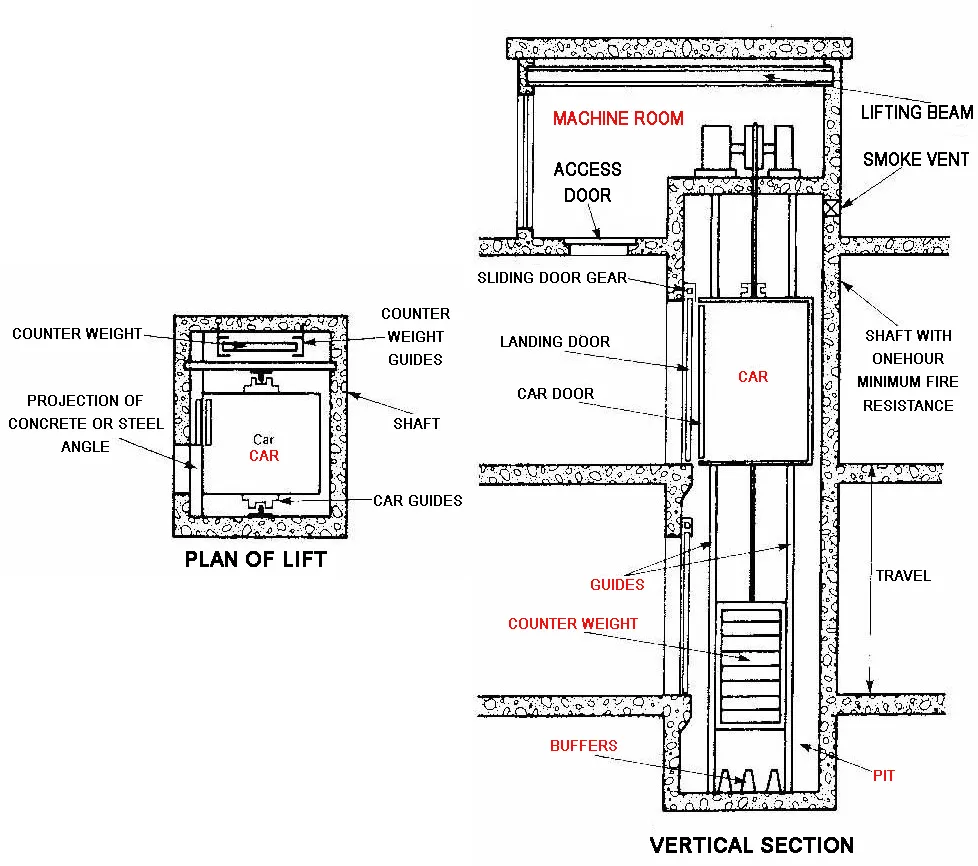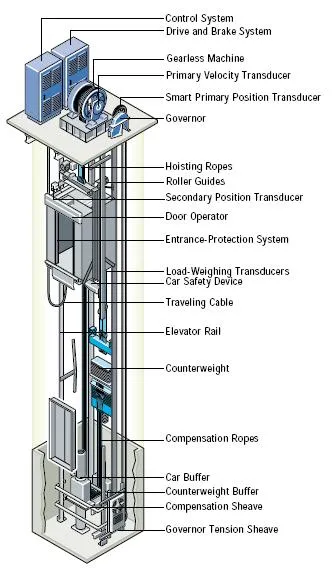If you want to know about the element of design or types of lifts or air distribution system, please click the link.
A lift, also known as an elevator, is a vertical transportation device used to move people and goods between different floors of a building. Its components include the elevator car, elevator doors, hoistway or shaft, elevator control system, safety systems, counterweights, guide rails, call buttons, emergency communication system, lighting, and ventilation.
Additionally, a lift may have a control panel, intercom system, door locking mechanism, buffer system, power supply, maintenance and monitoring systems, accessibility features, speed governors, car operating panel, and destination control system.
- Space limitation and compact building designs in construction of multi-storeyed buildings necessitating lifts or elevators in buildings.
- It is seen that an average man can go up to the height of 30mts (on steps in a single walk) beyond which he has to take rest for further going up.
- But when to and from journey (going up and down) becomes a routine, height of even more than 14.5mts becomes cumbersome due to which installation of elevators becomes almost in all buildings beyond 14.5mts or more than four storeys.
- For traffic rate exceeding 3200 persons per hour, escalators, which are having moving steps, are needed. 10-15% of the building construction cost for elevators if the building is very high.
1) Lift components

i) Hoistway or shaft
- No equipment except that forming a part of lift should be installed in lift well.
- All internal surface of lift should be kept flush.
- Side walls of the lift may also be made of RCC at least 15cm thick.
- The enclosing lift shafts shall have fire resistance of not less than 2 hours.
- Exit from the lift lobby shall through a self-closing smoke stop door of half hour resistance.
ii) Machine Room
- The machine room is meant for keeping all lift drive and control apparatus.
- The machine room should as far as possible be placed immediately above the lift well as this has several advantages such as reduced load.
- Lower capital cost, a smaller lift well for given size lift car and reduced power consumption compared with a machine room in basement.
iii) Lift Pit
Depth of lift pit depends on car speed and load on the car, which increases with increase in speed.
- min, pit depth – 1.6m
- waterproofing should be done in the lift pit.
- when exeeds 1.6m, ladder should be provided 0.75m above pit floor.
iv) Overheads
- Overheads depends on car speed and load.
- Overheads min. height- 4.8m
- It is the distance between the finished floor level of the last landing the bottom of the machine room.
- To take care of car-run by in case of the car or governed rope failing and over speeding of car due to high voltages.

v) Counterweight
- These are the weights attach to the one end of the rope to counter the balance the weight of the lift car and rated load of the car.
- It is – Counter weight = empty cage + 40%-50% of the counter wt.
vi) Guide rails
- provides track for the car and the counter weight both. It also keeps them in their position.
vii) Buffers
- fixed on the floor of the lift pit to reduce the impact on the lift car due to its overrun or failure of the governing rope.
2) Classification

- Passenger are lifted in building by lift cars that are lifted up or down by transaction force generated by lift driving machinery, which is always an electrical motor.
- Weight of car plus 40 to 50% of rated capacity of car is balanced by the counterweights which are provided at the other end. Counterweight are provided to minimise tractive effort.
- The driving machinery essentially consist of a motor, its brake and a drum or pulley. On basis of method of power transmission, lift can be classified as:
- Drum type
- Transaction type.
i) Drum type
- In this system car is attached to driving system by two number ropes out of which one is attached to a drum and other is attached to a counterweight.
- The drum is a form of spool on which end of rope is attached and rope is wounded or unbound during the movement of car.
- This system can be both under mounted or over mounted type.
- Drum type elevators have become obsolete now a day and are employed only on slow speed lifts.
ii) Traction type
- In this type of elevator one end of rope is connected to pulley and another to counter- weight.
- The tractive force is transferred to rope by means of friction between rope and a pulley (traction sheaves) over which ropes roll. The pulley is driven by an electric motor.
- The traction pulley may be attached to driving motor directly or other gear according to which the lift is called gearless or geared type.


Gearless traction electric elevators

- The gearless traction electric elevator could be employed in buildings of any height and operated at much higher speeds than steam-powered elevators.
- These elevators typically operate at speeds greater than 500 feet per minute.
- In a gearless traction machine, six to eight lengths of wire cable, known as hoisting ropes, are attached to the top of the elevator and wrapped around the drive sheave in special grooves. The other ends of the cables are attached to a counterweight that moves up and down in the hoistway on its own guiderails.
- The combined weight of the elevator car and the counterweight presses the cables into the grooves on the drive sheave, providing the necessary traction as the sheave turns.
Geared traction elevators

- As the name implies, the electric motor in this design drives a worm and-gear-type reduction unit, which turns the hoisting sheave. While the lift rates are slower than in a typical gearless elevator, the gear reduction offers the advantage of requiring a less powerful motor to turn the sheave.
- These elevators typically operate at speeds from 38 to 152 meters (125-500 ft) per minute and carry loads of up to 13,600 kilograms (30,000 lb).
- An electrically controlled brake between the motor and the reduction unit stops the elevator, holding the car at the desired floor level.
All of these components work together to provide safe and efficient vertical transportation within a building.